Exploring the Depths of Cable Wakeboarding
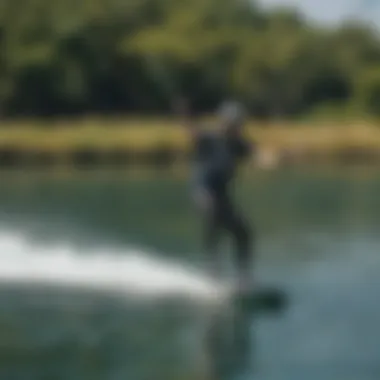

Intro
Cable wakeboarding has become a staple in the watersports scene. It's not just about zipping across a lake or trying to impress your friends with acrobatic stunts. This sport pulls together a unique blend of technical skill, creative flair, and a community that thrives on enthusiasm and camaraderie. Each twist of the cable and leap into the air tells a story not just of individual achievement, but of a collective passion for the water.
In this exploration, we'll peel back the layers to understand the mechanics behind cable wakeboarding. We'll dive into why many enthusiasts prefer this method over traditional boat towing, what gear is essential for both novices and experts, and the techniques that can elevate your performance. Additionally, we'll touch on safety practices and explore the vibrant community that forms around this exhilarating sport.
Whether you’re a fresh face to the sport or someone who’s been riding the waves for years, you’ll find valuable insights here—like discovering hidden gems of knowledge that can make your ride smoother and more enjoyable.
This journey promises to furnish you with all the insight needed to navigate the waters of cable wakeboarding, from gear essentials to safety tips, giving you a comprehensive guide to making the most of your time on the water.
Prologue to Cable Wakeboarding
Cable wakeboarding is gradually carving out its own niche in the vast realm of watersports, drawing enthusiasts who are eager to blend athleticism with creativity on the water. This activity uniquely marries elements of skiing, snowboarding, and surfing, presenting a myriad of benefits that cater to both novice ardeventurers and seasoned pros. In this section, we will explore what cable wakeboarding entails, along with its historical roots and significance.
Defining Cable Wakeboarding
At its core, cable wakeboarding involves being towed across water on a wakeboard, similar to traditional wakeboarding. However, rather than relying on a boat, riders are pulled by a fixed, overhead cable system. This setup not only allows for a consistent pull but also enables a smoother, more controlled experience. Riders can experience the thrill of speed and agility while executing precision tricks and jumps.
The attraction of cable wakeboarding lies in its accessibility. With cable parks cropping up in various locations, a wider audience can engage, transcending the limitations often associated with boat-dependent wakeboarding. Riders have the freedom to practice jumps and tricks without the need for a boat, allowing for creativity and personalized development. Moreover, this format fosters a community atmosphere, where beginners and experts alike can share a line.
Historical Context
Understanding the roots of cable wakeboarding shines a light on its evolution and growing popularity. The sport can trace its origins back to the early 1970s when innovative thinkers began adapting water-skiing techniques for wakeboarding. The vital breakthrough came with the introduction of the cable system in the 1980s in Europe, which significantly improved the wakeboarding experience.
In Germany, the first commercial cable park opened in 1991, setting the stage for what would become a global phenomenon. From that point, cable wakeboarding has dramatically expanded, with parks popping up not just in Europe but across Asia, Australia, and North America. Today, you can see cable wakeboarding events showcasing top talents, while casual riders hone their skills at local parks.
"Cable parks are the as the heartbeat of wakeboarding, propelling us into a new era where everyone can ride, learn, and thrive together."
This shift has been crucial for the sport, inviting diverse participants and cultivating an inclusive community. Now, more people than ever are able to experience the joy and excitement that cable wakeboarding offers, shedding light on its importance to the future of watersports.
As we delve deeper into the various facets of cable wakeboarding in the following sections, we will uncover essential gear, techniques, and safety measures that enrich this remarkable sport.
Difference Between Cable Wakeboarding and Traditional Wakeboarding
Understanding the contrast between cable wakeboarding and traditional wakeboarding is pivotal for anyone looking to dive deep into this sport. Each method presents its own unique experiences, benefits, and learning curves that cater to different preferences and skill levels. This section will dissect the nuances between the two, helping you grasp not just the mechanics, but also the culture and environment surrounding these water-based activities.
Towing Mechanism
At its core, the difference in towing mechanisms is quite striking. Traditional wakeboarding relies on a boat as the primary source of propulsion. The boater and rider must work in sync, which can be a dance of sorts, requiring significant communication and timing. On the other hand, cable wakeboarding utilizes a fixed cable system that moves around a course. This setup allows for a steady pull, enabling the rider to focus more on their technique rather than on getting the boat driver to hit that sweet spot in speed.
The advantage of the cable system extends beyond just ease of use. Since the cable can be operated at various speeds, riders can find a pace that truly suits their skill level. For instance, beginners may prefer a slower pull as they are figuring out their balance, while more seasoned wakeboarders might favor a quicker pace for jumps and tricks. This flexibility fosters a more inclusive environment where everyone, from newcomers to seasoned pros, has space to grow.
Skill Development
Cable wakeboarding promotes a different approach to skills development. With the constant pull of the cable, riders can practice repeatedly without waiting for a boat to circle back. This immediate feedback loop translates into faster learning. Riders can tweak their technique and try new tricks in a shorter span of time.
Moreover, because cable parks often feature obstacles—like rails and kickers—riders have opportunities to engage in more diverse skill sets than they typically might with a boat. Each attempt can be a lesson learned. Think of it like striking while the iron is hot; it's much easier to fine-tune your craft when the conditions are right, and when you can stay on the water longer without excessive break times.
Accessibility
When it comes to accessibility, cable parks provide a more welcoming environment for those wanting to dip their toes into wakeboarding. Unlike traditional settings, where boat ownership can come with considerable overhead—fuel costs, maintenance, insurance—a visit to a cable park usually involves just an entrance fee. Many parks offer rental options for gear, so you don't have to sink a fortune into equipment right off the bat.
In addition, the social aspect of cable parks often turns them into community hubs. The atmosphere is more relaxed compared to the boat experience, where the number of wakeboarders is limited by rope length. In a cable park, multiple users can ride simultaneously, creating a communal vibe that enriches the overall experience.
"Cable parks transform the learning curve into a bridge, making wakeboarding more accessible to everyone, regardless of skill level. They let aspiring riders connect not just with the water, but with a community that thrives on shared passion."
As we progress through this article, keep these differences in mind. Not only will they offer insight into the technical aspects of wakeboarding, but also challenge you to consider which approach aligns best with your personal style and ambitions. Understanding these elements will pave the way for a more nuanced appreciation of the sport as a whole.
Equipment Essentials for Cable Wakeboarding
When you step onto the cable wakeboarding scene, the importance of the right equipment cannot be emphasized enough. The gear you choose isn’t just a matter of convenience; it plays a crucial role in your performance, safety, and overall enjoyment of the sport. In a world where the thrill of the ride often meets the serenity of the water, having quality equipment can make all the difference.
Wakeboard Types
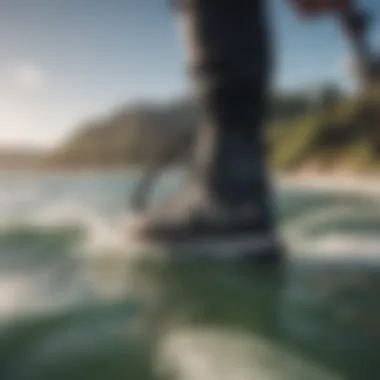
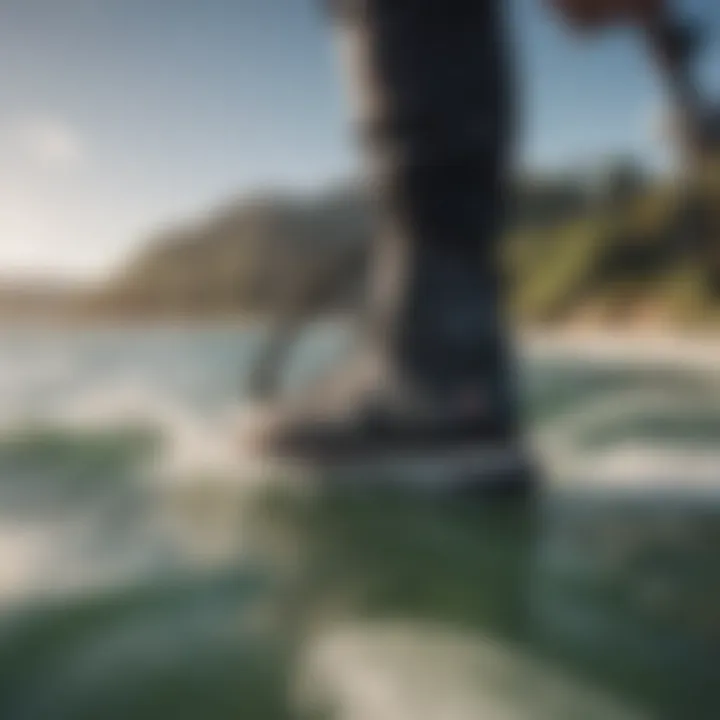
Understanding the various types of wakeboards is vital for any aspiring wakeboarder. Each type caters to different skill levels and riding styles.
- Standard Wakeboards: These are all-rounders, suitable for beginners to advanced riders. They typically feature a symmetrical shape, making them versatile for various tricks.
- Crossover Boards: Ideal for those who want to dabble in both wakeboarding and waterskiing. These boards tend to have a bit more width and a hybrid rocker profile.
- Cable-Specific Boards: Designed specifically for cable parks, these boards often boast a softer flex to absorb the impact from rails and sliders. They commonly have a durable construction to withstand frequent use and grinds.
- Pro Model Boards: Tailored for professionals, these boards reflect specific shapes and sizes, often designed by the riders themselves. If you're aiming for high-level performance, investing in a pro model might elevate your game.
Choosing the right wakeboard can be a game-changer. It can provide stability, control, and the ability to master tricks with greater ease.
Bindings and Boots
Bindings and boots are crucial for a secure fit while you're tearing up the water. The right bindings ensure that you stay connected to your board without risk of injury.
- Closed-Toe Bindings: These offer more support and are generally warmer, making them suitable for colder environments.
- Open-Toe Bindings: Generally more adjustable, allowing for a bit of room and comfort. They can be a good option for sharing gear among friends or family, due to their flexible sizing.
- Adjustable Bindings: Ideal for novices and growing riders, these offer an easy way to adjust to different foot sizes. They usually feature velcro straps or similar fasteners for easy modification.
With the proper bindings, you gain the confidence to push your limits, whether you're practicing jumps or cruising smoothly on the water.
Safety Gear
Every great rider knows that safety should never be tossed aside. The joy of wakeboarding needs to be matched with prudence to ensure a long and enjoyable journey in the sport. Here are some essentials:
- Life Jackets: Always wear a life jacket. Look for a comfortable, well-fitted vest that allows for a range of motion while still providing buoyancy.
- Helmets: These may not be the first thought when gearing up, but they can protect against head injuries from falls or collisions. Consider a helmet that’s specifically designed for watersports to ensure it meets safety standards.
- Wetsuits: Not just for warmth; wetsuits safeguard against abrasions and minor impacts. A good wetsuit can shield your skin from scrapes as you wipe out.
- Impact Vests: These are light and provide extra cushioning when you hit the water at speed. If you're practicing advanced tricks, this lies in good sense.
Adopting the right safety gear will always keep you one step ahead of potential risks, allowing for carefree riding once you hit the water.
"In wakeboarding, just as in life, preparation is the key. Gear up wisely, and the fun will follow!"
By focusing on selecting quality equipment, you’ll not only enhance your wakeboarding experience but also improve your skills on the water. Whether you are starting out or an experienced rider, investing time in understanding these essentials is key to unlocking your full potential and enjoying the thrill of cable wakeboarding.
Techniques for Mastering Cable Wakeboarding
Navigating the waters of cable wakeboarding requires more than just the right gear; it demands a keen understanding of various techniques. Whether you’re a newcomer seeking to find your rhythm or a seasoned rider aiming to refine your skills, mastering these techniques is pivotal. They not only enhance your ability to perform but also contribute to a safer and more enjoyable experience.
Getting Started
Starting cable wakeboarding can feel a bit like jumping into the deep end, especially for those who have never attempted watersports before. The first step is familiarizing yourself with your surroundings and the equipment. Begin by engaging with friendly instructors who can guide you through the basic operations of the cable system.
Here's a simple roadmap to ease you into the waters:
- Choosing the Right Park: It’s essential to select a cable park that caters to your skill level. Some parks have beginner zones while others cater to more experienced riders.
- Understanding the Equipment: Don’t shy away from asking questions about the wakeboard, bindings, and the cable setup. Knowledge about your gear is vital, especially how to properly wear the bindings for comfort and security.
- Body Positioning: Learning to position your body correctly while getting pulled can make a world of difference. Keeping your knees slightly bent, leaning back, and looking forward helps maintain balance and control.
"A confident stance can turn the tide between a spectacular ride and a wipeout."
Basic Tricks
Once you’ve eased into the groove, it's time to sprinkle in some basic tricks. Mastering these can elevate your ride and build essential muscle memory. Here’s where fun meets function:
- 1. The Ollie: This is one of the foundational moves in wakeboarding. To perform an ollie, simply load up your back foot and then spring off the tail of the board while pulling your knees up. It allows for a smooth transition over obstacles.
- 2. The 180: Get comfortable with this trick by rotating your body while in motion. Start with your body facing backward (switch stance), then pivot your head around and carry your shoulders with you—voila, you’re facing the other direction!
- 3. The Surface Trick: A fun way to get accustomed to the board's dynamics is to practice surface tricks like slides and spins while on the water's surface. It helps to improve board control without needing the height of a jump.
Advanced Maneuvers
As your confidence grows, so too can your ambitions. Diving into higher-level tricks opens up the world of creativity in your riding.
- Handling Jumps: Practice your take-offs on small jumps before attempting bigger ramps. Your approach speed, body position during take-off, and landing stance are all critical elements to perfecting this.
- Grabs: Once airborne, grabbing your board adds flair. It means reaching down to hold your board in mid-air, which can be executed in various ways such as the melon or nose grab.
- Inverting Tricks: Tricks like the backflip or the front flip require an understanding of body rotation and timing in conjunction with the cable’s pull. It’s advisable to practice on a trampoline or seek safe environments to learn these skills before hitting the water.
With patience and practice, each of these techniques will contribute to both your skillset and confidence on the water. Remember, every expert was once a beginner, and the learning journey is what makes cable wakeboarding not just a sport, but a lifestyle.
Key Locations for Cable Wakeboarding
Finding the right location to practice cable wakeboarding is essential for both enjoyment and skill development. Not only do these locations provide the necessary setups, but they also foster communities, making the experience even richer. Facilities that offer cable wakeboarding are typically tailored to various skill levels, ensuring that everyone from amateurs to seasoned riders can find their place. This section will explore some of the global hotspots as well as local parks and facilities dedicated to this fascinating sport.
Global Hotspots
When we think of premier cable wakeboarding locations, a few names tend to pop up due to their excellent conditions and vibrant communities. Here are some of the must-visit spots:
- Waketour Resort in Thailand: Known for its picturesque views, the resort has multiple cable setups catering to beginners and experts alike. The combination of warm weather and a supportive community enhances the overall experience.
- Cable Park at Lagoons in Florida, USA: This establishment is famous for its professionally designed layouts and events that attract riders from around the globe. Waters around Florida are ideal, providing consistent warm weather all year.
- Flugtag in Germany: In the heart of Europe, this cable park offers a unique atmosphere combining culture and sports. The facilities here often host high-level competitions, making it a thrilling spot to witness talented riders push their limits.
- Cabo Water Park in Mexico: This location is revered for its stunning scenery and a wide variety of obstacles. Riders here enjoy the natural beauty while honing their skills on the water.


These hotspots not only provide exceptional facilities but also create an exhilarating atmosphere where camaraderie thrives. It's not just about the sport; it’s about the experience shared with fellow enthusiasts from all walks of life.
Local Parks and Facilities
In addition to world-renowned destinations, countless local parks and facilities cater to those looking to dip their toes into cable wakeboarding without venturing too far. Here’s a look at some characteristics to consider:
- Accessibility: Many local parks often make the sport accessible to a broader audience, with affordable fees and beginner-friendly setups.
- Community Events: Local venues frequently host friendly competitions and social gatherings, providing opportunities for networking and skill enhancement. This ensures riders continue to push boundaries while forming lasting friendships.
- Diverse Features: These parks often feature a variety of jumps, sliders, and other obstacles that cater to different skill levels, allowing everyone to progress at their own pace.
Some notable parks in various regions include:
- Wake Park in South Carolina, USA: This facility offers various cable systems and frequently organizes meetups for local riders.
- Bavarian WakePark in Germany: A captivating local facility tucked away in nature, providing an inviting atmosphere for both learning and competition.
- Splash Water Sports in Australia: Popular among both locals and tourists, this park features multiple cable options for all rider capabilities, making it a great spot to improve.
By exploring these local parks, riders can dive into the cable wakeboarding community on a more personal level.
"Whether you’re chasing the thrill of advanced tricks or enjoying a leisurely day out, the right location is what makes cable wakeboarding truly unforgettable."
In summary, the key locations for cable wakeboarding play an integral role in shaping the sport's experience, fostering communities, and inspiring riders across the globe. Each park or facility comes with its unique charm and opportunities, urging enthusiasts to find their sweet spot in the ever-evolving world of cable wakeboarding.
Assessing Risks and Ensuring Safety
Engaging in cable wakeboarding can be exhilarating, yet it's crucial to spotlight the importance of assessing risks and ensuring safety. This sport, while thrilling, presents its own set of challenges and potential hazards. Understanding and mitigating these risks not only protects the individual athlete but also enhances the overall experience on the water.
One significant aspect to consider is the varying skill levels of riders, which can lead to different types of injuries and accidents. Beginners may lack the experience necessary to navigate the nuances of the cables, while seasoned wakeboarders might push their limits to execute complex maneuvers, inadvertently putting themselves at risk. \n
Common Injuries
Injuries in cable wakeboarding are often a product of falls, collisions, or improper technique. Some common injuries include:
- Wrist Sprains: Often the result of falling with hands extended to break a fall.
- Knee Injuries: Abrupt twists or poor landings can put excess strain on knees, potentially leading to tears or sprains.
- Shoulder Injuries: These can occur during falls or when attempting tricks, as the arms may absorb the force awkwardly.
- Head Injuries: Though less common, collisions with the cable or other objects can lead to concussions or other serious impacts.
Recognizing these common injuries underscores the significance of safety measures and informed riding practices.
Preventative Measures
Preventative measures are essential in managing risks effectively. Here are several strategies that can help:
- Proper Gear: Always wear a certified helmet and impact vest, which can prevent serious injuries in the event of a fall.
- Warm-Up Exercises: Engaging in stretches and warm-ups specific to riding can prepare muscles and reduce the likelihood of strains.
- Skill Assessment: Before hitting the water, it's beneficial to have a clear understanding of one’s skill level and choose the appropriate course or cable park that matches that level.
- Supervision and Instruction: For newcomers, engaging with an instructor or experienced rider can provide essential insights and techniques. This mentorship can make a world of difference in developing safe riding habits.
- Awareness of Surroundings: Riders should be conscious of their environment—be it the water depth, other riders, and obstacles around. Awareness is key to avoiding accidents.
"Safety isn't just a policy; it's a practice that defines how we engage with our passion."
By implementing these safety measures, both new and experienced riders can enjoy the thrill of cable wakeboarding while significantly decreasing the likelihood of injury. As the sport grows in popularity, fostering a culture of safety will enhance the experience for everyone involved.
Community and Culture Around Cable Wakeboarding
Cable wakeboarding isn't just a sport; it’s a vibrant community where passion meets creativity. Understanding the tightly-knit culture around it reveals how essential the community is to the sport's growth and the enjoyment of its participants. Beyond mere recreational activity, it fosters connections among enthusiasts, builds friendships, and promotes a collaborative atmosphere. Members share tips, tricks, and even their gear, making it more accessible.
Clubs and Organizations
Joining a club or organization related to cable wakeboarding can enhance your experience significantly. Clubs often organize weekly meet-ups, workshops, and even training sessions. Commonly, these groups range from local parks’ enthusiasts to larger, nationally recognized organizations. Their influence can’t be understated in promoting safety, skill development, and camaraderie among members.
- Local Clubs: Many areas may have local clubs connected to specific parks. These clubs often have dedicated spots at parks which provide members with discounts or special access. They become the heartbeat of the local scene, rallying participants for cleanup days or skill-sharing weekends.
- National Organizations: Bodies like the World Wake Association serve a bigger role, advocating for cable wakeboarding on a global level. They help set standards and contest regulations. By participating in these organizations, riders not only improve their skills but contribute to the sport’s visibility and legitimacy.
- Networking Opportunities: In these club environments, connections form that can lead to sponsorships or friendships that last lifetimes. When you are part of a community, there’s often someone ready to lend a board or share a riding tip, making the journey less isolating.
Events and Competitions
Events and competitions play a key role in cultivating the culture of cable wakeboarding. Whether it’s a local competition or a large international event, these gatherings bring participants together in a spirit of friendly rivalry.
"Events not only test your skills but also create memories that last a lifetime—each flip and splash imprints on our hearts."
- Local Contests: Many parks organize small competitions during peak seasons. These are great for beginners looking to dip a toe into competitive riding without overwhelming pressure. Even seasoned riders enjoy them for the sheer fun and community spirit.
- National and International Events: Major competitions attract riders from all over the globe, showcasing talents and innovative tricks. Events like the Wakeboard World Championships draw significant attention, offering a platform for riders to demonstrate their skills under the glare of cameras.
- Festivals: Some parks host wakeboarding festivals that combine competitions, food, music, and other activities. These gatherings provide a rich and lively atmosphere where industry brands showcase new gear and riders exchange stories and experiences.
Engaging in these events not only solidifies your place in the community but can also enhance your skills through exposure to different riding styles and techniques. They highlight the sport's ecosystem—where the thrill of competition mingles effortlessly with camaraderie and shared passion.
In essence, the community around cable wakeboarding is a tapestry woven from diverse threads. From local clubs to international competitions, the culture nurtures growth, friendship, and innovation, making it more than just a sport.
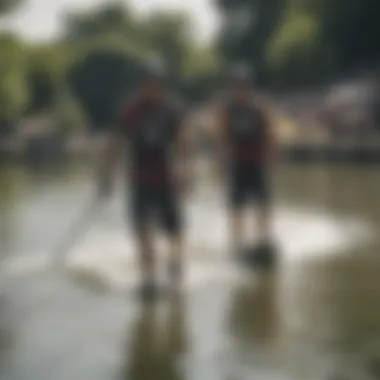
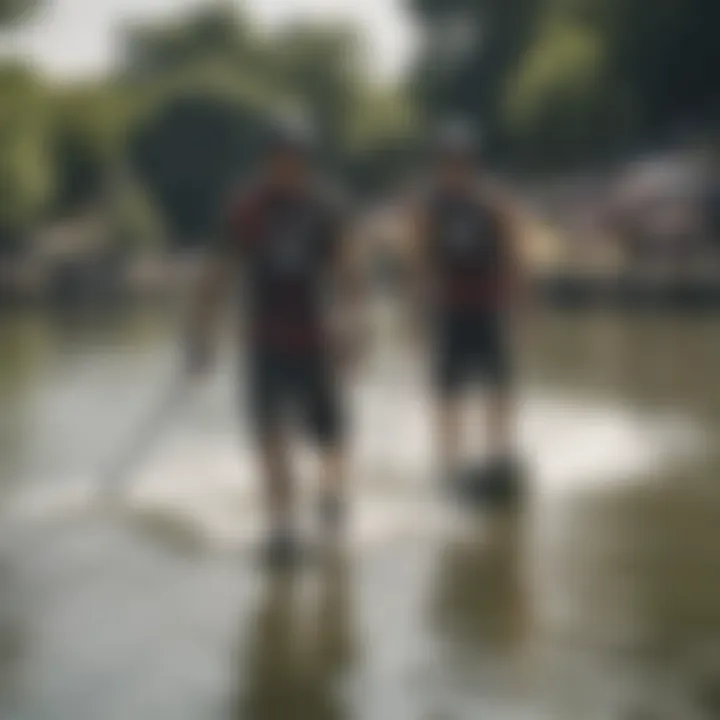
Environmental Considerations
Cable wakeboarding, often seen as an exhilarating sport, carries with it crucial environmental implications that cannot be disregarded. These considerations delve into the interplay between the sport and the delicate ecosystems surrounding the water bodies. It's not just about the thrill of gliding over water; it also involves recognizing our role as custodians of these environments. In the following sections, we will explore the impact on water systems and the sustainable practices that can help mitigate negative effects, fostering a healthier ecosystem for future enthusiasts.
Impact on Water Systems
Cable wakeboarding utilizes a system that often recycles the same volume of water repeatedly. This practice can lead to significant alterations in the quality and health of water systems. With regular wakeboarding activities, pollutants, chemical residues, and sedimentation can find their way into the waterways. It's like stirring a pot; the more we disturb the water, the more sediment and debris gets churned up, potentially harming the aquatic life that relies on clean environments.
Moreover, the intense activity can increase noise pollution, which may disturb local wildlife. Animal species dependent on quiet habitats might find it challenging to thrive near busy wakeboarding parks. The ecological balance is at stake, making it imperative for wakeboarding facilities to assess their operations critically. Regular monitoring of water quality and habitat health is essential to ensure that wakeboarding does not make a negative mark on the environment.
Key Considerations for Water Impact:
- Water Quality Monitoring: Regular checks to gauge chemical levels and pollutants.
- Minimal Disturbance: Implementing guidelines to reduce sediment churn in sensitive areas.
- Local Wildlife Studies: Partnering with ecologists to study the impact on local flora and fauna.
"Every drop in the ocean counts. As wakeboarding grows, so must our responsibility towards water care."
Sustainable Practices
As the sport evolves, so does the responsibility of its participants and facilities in adopting sustainable practices. Transitioning toward greener methods ensures that cable wakeboarding coexists harmoniously with the environment rather than at its expense. Initiatives can vary from simple waste management to large-scale ecological restoration projects.
- Eco-Friendly Equipment: Using biodegradable or recyclable materials in wakeboards and gear reduces waste and pressure on landfills.
- Water Management: Employing technologies that maximize water conservation, like rainwater harvesting for non-potable use.
- Community Awareness: Educating the wakeboarding community on responsible practices, such as proper waste disposal and the importance of maintaining clean environments.
- Volunteering for Clean-Ups: Organizing events where enthusiasts come together to clean local waterways fosters a sense of community and responsibility.
- Sustainable Facility Design: Integrating energy-efficient systems within wake parks, using solar power to run operations where feasible.
By adopting such practices, cable wakeboarding can mitigate its ecological footprint while enhancing its appeal as a responsible sport. The objective is clear: ensure that this thrilling sport does not come at the expense of the very waters that draw participants in.
As stewards of our natural landscapes, waking the line between excitement and preservation is not just advisable, it's essential.
Future Trends in Cable Wakeboarding
The world of cable wakeboarding is in a constant state of flux, adapting and evolving to meet the needs of its participants and the environment. It’s important to peer into the future of this sport so that enthusiasts can stay ahead of the curve. Understanding future trends can help athletes, facility operators, and instructors make informed decisions, enhancing their wakeboarding experience.
Technological Advances
The role of technology in cable wakeboarding can't be overstated. Innovations are continually shaping the way riders approach the sport and the subsequent experiences on the water. Consider the advent of smart cable systems that regulate speed and pull based on the rider's experience level. This kind of tech can make a huge difference for both newcomers and seasoned wakeboarders. Just imagine a system that can analyze your tricks and provide real-time feedback to fine-tune your performance.
Moreover, advancements in wakeboard design are also noteworthy. Manufacturers are now using lighter, more durable materials that elevate performance while reducing fatigue. Boards engineered with innovative flex patterns can provide enhanced responsiveness, which is essential for executing tricks. The right board can mean the difference between a stylish landing and an unexpected plunge into the water.
Growing Popularity
It's clear that cable wakeboarding is gaining traction globally. There’s something about the community and the shared experience that pulls people in. Local parks and facilities are popping up everywhere, offering easy access to the sport for a wider audience. This increase in availability encourages participation from families and individuals who might not have considered wakeboarding before.
Furthermore, social media plays a key role. Athletes showcasing their skills online are drawing more eyes to cable parks. When you see a gravity-defying trick on your feed, you're likely to think, "I could do that" or at least give it a shot. The power of visual influence can’t be ignored; it acts as a recruitment tool for newcomers.
As the sport continues to evolve, we can expect more inclusive events and competitions. Traditional barriers are breaking down, allowing for increased representation in all facets of cable wakeboarding, from the riders to the organizers. This trajectory not only enriches the community but also lays the groundwork for a diverse and vibrant future.
"The only constant is change, and in cable wakeboarding, that rings particularly true."
The future of cable wakeboarding is bright with promise. By embracing technological advancements and encouraging a diverse participation, this sport is set to flourish in ways that will keep pushing boundaries and inspiring new generations to take to the water.
Ending
The conclusion serves as an essential wrap-up of the discussion on cable wakeboarding, stitching together the diverse threads woven throughout the article. It emphasizes not just the technical prowess required for the sport, but also highlights its vibrant community, environmental aspects, and the array of venues available for enthusiasts. This sport is not merely about mastering tricks on the water; it's about the culture that thrives around it, the friendships forged, and the exhilarating experiences shared.
Recap of Key Points
In recapping the key points discussed:
- Cable wakeboarding is distinct from traditional wakeboarding, showcasing its own unique towing mechanisms and techniques.
- Accessibility plays a crucial role, with numerous parks offering affordable options for newcomers and seasoned athletes alike.
- Various gear essentials such as wakeboards, bindings, and safety equipment were emphasized, along with the importance of wearing appropriate safety gear.
- Techniques for mastering the sport were laid out, ranging from beginner tips to advanced maneuvers to build confidence and skill.
- Finally, the sustainability of the sport and its growing popularity as a vibrant community united by a love for water, adventure, and creativity was highlighted.
This summary encapsulates how cable wakeboarding is more than a sport; it embodies a lifestyle that encourages collaboration, excitement, and respect for nature.
Encouragement for Participation
Encouragement for participation in cable wakeboarding cannot be overstated. This sport welcomes individuals from all walks of life, regardless of skill level. If you have ever fancied gliding across the water, feel the rush of air on your face, or simply seek to challenge yourself and learn something new, then give it a go.
Local facilities often provide lessons led by experienced instructors, making it easy to ease into the sport. Start with basic lessons to grasp the foundational skills, and before you know it, you'll be tackling your first jump or spin. It's all about making memories and embracing the learning journey.
"Every expert was once a beginner."
Fostering personal connections within the wakeboarding community can transform an isolated hobby into a shared lifestyle. Events and competitions are plentiful, providing ample opportunities to connect with fellow enthusiasts. Take the plunge, step out of your comfort zone, and immerse yourself in this exhilarating adventure. Your first ride could be the start of something unforgettable.















